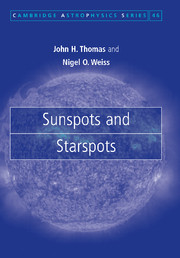Book contents
- Frontmatter
- Contents
- Preface
- 1 The Sun among the stars
- 2 Sunspots and starspots: a historical introduction
- 3 Overall structure of a sunspot
- 4 Fine structure of the umbra
- 5 Fine structure of the penumbra
- 6 Oscillations in sunspots
- 7 Sunspots and active regions
- 8 Magnetic activity in stars
- 9 Starspots
- 10 Solar and stellar activity cycles
- 11 Solar and stellar dynamos
- 12 Solar activity, space weather and climate change
- 13 The way ahead
- Appendix 1 Observing techniques for sunspots
- Appendix 2 Essentials of magnetohydrodynamic theory
- References
- Index
9 - Starspots
Published online by Cambridge University Press: 28 October 2009
- Frontmatter
- Contents
- Preface
- 1 The Sun among the stars
- 2 Sunspots and starspots: a historical introduction
- 3 Overall structure of a sunspot
- 4 Fine structure of the umbra
- 5 Fine structure of the penumbra
- 6 Oscillations in sunspots
- 7 Sunspots and active regions
- 8 Magnetic activity in stars
- 9 Starspots
- 10 Solar and stellar activity cycles
- 11 Solar and stellar dynamos
- 12 Solar activity, space weather and climate change
- 13 The way ahead
- Appendix 1 Observing techniques for sunspots
- Appendix 2 Essentials of magnetohydrodynamic theory
- References
- Index
Summary
Starspots are analogues of sunspots that appear as dark patterns in a stellar atmosphere and modulate the radiative output over the visible hemisphere of the star. Early detections of starspots, beginning with the work of Kron (1947), are discussed in Section 2.8. Intensity patterns of various types have been detected on many stars, not all of which are analogous to sunspots; for instance, optical aperture synthesis has revealed convection cells on Betelgeuse. Here we shall restrict attention to those patterns that are most like sunspots, although in almost all cases the dark areas are substantially larger than spots on the Sun, for otherwise they would not have been detectable. A good example of such a large starspot has already been shown in Figure 1.8. We infer that starspots share with sunspots a magnetic origin.
The motivation to study starspots comes from many areas of investigation, including the study of magnetoconvection and the study of stellar activity and patterns of emergence of magnetic flux. Starspots and other surface intensity patterns provide the most accurate means of determining stellar rotation periods and also allow the detection of surface differential rotation, a key ingredient in understanding stellar dynamos. The possible effects of starspots often have to be considered in interpreting data related to stellar pulsations or searches for extrasolar planets.
Methods for detecting and mapping starspots on stellar surfaces have advanced rapidly over the past two decades.
- Type
- Chapter
- Information
- Sunspots and Starspots , pp. 158 - 183Publisher: Cambridge University PressPrint publication year: 2008

